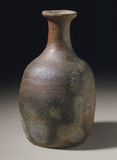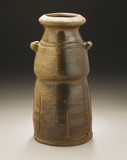Tōyō as born in Inbe to a hereditary pottery family of Kaneshige Baiyō, whose family had run the same kiln in Bizen continuously since the Muromachi period. Tōyō learned exemplary techniques for potting from Baiyō. He is noted for being a founder of the Japan Art Crafts Association (Nihon kōgeikai) in 1955, and was named a Living National Treasure in 1956. He is of a group referred to as the "Momoyama revival movement" active from the late 1920s, who unearthed historical works and reverse-engineered them to revive their making in the present day, named a protector of cultural assets in 1942. The special aspects of Momoyama Bizen wares was revealed as the clay preparation, with repeated grinding of the clay soil, and preservation of that filtered clay for generations within a family. He considered the clay of Bizen "more important than rice" in its rarity and character. With proper kiln engineering his greatest skill was to bring out this character in his finished work.
Tōyō had experimented with kiln building from the age of 20, devising fire-proof shelving for kilns in 1916, experimenting with Dutch-style muffle kilns in 1921, building a very large climbing kiln in 1927. He also devised proper loading techniques to take advantage of fire markings, achieving the surface character of old Bizen ware in 1930 and creating the hidasuki red streak technique of firing objects wrapped with salted rice straw. By 1941, Tōyō had reintroduced all of the firing effects of old Bizen, seen in works from the Muromachi and Momoyama periods, and beloved by tea connoisseurs. Tōyō became the director of the Japan Crafts Association in 1962 and received an imperial medal, the Order of the Rising Sun, Gold Rays with Rosette, in 1967. He revitalized interest in Bizen ware which continues to the present. hg
Tōyō Kaneshige
5 records
Include records without images
About this artist




